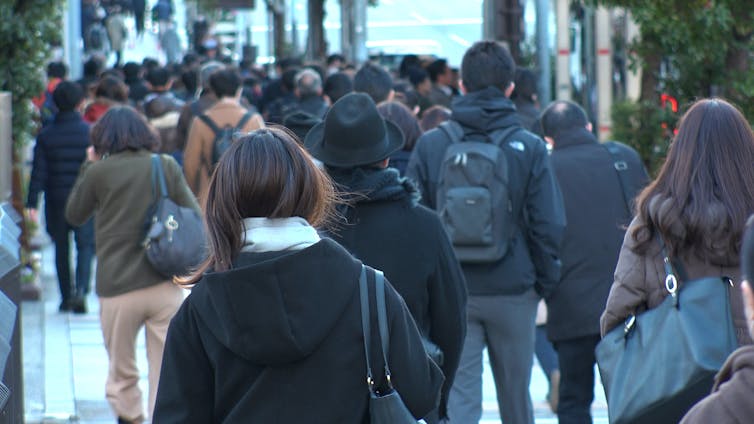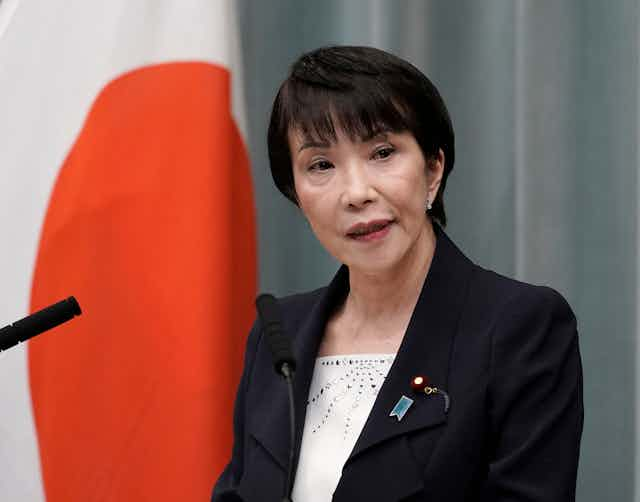She has been billed as an underdog, but Sanae Takaichi, a staunch conservative MP and ally of former prime minister Shinzō Abe, has announced her bid to become the next leader of the ruling Liberal Democratic Party in Japan. If successful, she would almost certainly become Japan’s first woman prime minister.
Abe publicly endorsed her after the sitting prime minister and LDP leader, Yoshihide Suga, announced on September 3 that he was stepping down as party leader. Takaichi shares many of Abe’s views, such as revising Japan’s pacifist constitution. Her platform, which she has dubbed “Sanaenomics” – a reference to the former PM’s “Abenomics”, includes extra funding to help businesses affected by the COVID pandemic as well as laws to enable the government to impose strict lockdown measures – something not yet seen in Japan.
Read more: Japan: why PM Suga unexpectedly stepped down – and what happens next
But she is widely seen as an unlikely candidate, without her own power base in the LDP, whose grassroots members will vote in the leadership election. She told journalists:
It’s like an ant challenging an elephant — perhaps that’s what everyone thinks. When I first ran for election, it was a time when being a woman was a disadvantage. But it’s totally different now compared to 30 years ago.
Women on the outside
Gender equality is not something one readily associates with politics in Japan, which is ranked 120th out of 156 countries in a gender gap survey compiled by the The World Economic Forum. Women achieved the vote in Japan after the second world war. At the general election for the House of Representatives on April 10, 1946, about 13.8 million women exercised the right to vote for the first time and 39 women became the Diet members. This represented just 8.4% of the seats, but it was a historically significant moment for Japanese women and Japanese politics as a whole.
Seventy-five years on, the political gender gap has not improved much. According to the Inter-Parliamentary Union (IPU) – a global organisation of national parliaments, as of September 2021 only 9.9 % of members in the House of the Representatives are women and with representation in the House of Councillors not much better at 23%.

These numbers show that Abe’s pledge to increase the number of women in management positions to 30% across different fields by 2020 – a key part of his “Womenomics” plan, has failed to make a significant impact on his country’s political system.
‘Womenomics’
In 1999, US-born former Goldman Sachs strategist turned venture capitalist, Kathy Matsui, coined the term “womenomics”, arguing that female economic advancement would be necessary to improve the economy. Matsui – who recently launched MPower Partners Fund with two female colleagues – pointed out in an article in the Japan Times in 2019 that the situation has not changed much over the 20 years and argued for gender quotas in parliament.
Women in politics remain hampered by old-fashioned attitudes and practices. Takae Itō and Ayano Kunimitsu have complained about the lack of family-friendly measures for Japanese MPs. Makiko Yamada, former cabinet public relations secretary for the Suga cabinet, has commented that female politicians are pressured to work and act like men or won’t be promoted.
There are a few signs that Takaichi will make gender equality a defining issue in her campaign. Writing this month in the conservative magazine, Bungei Shunjū, she says nothing about gender equality or any other equality issues, including LGBTQ issues. Instead, Takaichi emphasises her economic policy – which she has dubbed “Sanaenomics”, stressing that it is basically “new Abenomics – which aims to increase inflation by 2% through "bold monetary easing”, “flexible fiscal stimulus” and “investment in crisis management and growth”.
Presenting her platform at a press conference on September 8, Takaichi explained her plans in some detail. As well as the economic measures mentioned above, she prioritised technological advancement, national security, COVID-mitigation measures including vaccination and border control, flexible working, defence against cyberwarfare and, to a lesser extent, female issues, including the introduction of a tax credit for childcare.

When confronted by the press about her perceived lack of empathy towards the socially vulnerable, she was quite honest, explaining that she was doing what she believed was right at the time, but she was willing to take criticism on board.
What are her chances?
Takaichi is aware that to create a robust and capable administration, she needs the confidence of the LDP and the public. Despite Abe’s backing, her public support rate is a mere 4%, according to a survey conducted on September 4-5 by Kyōdō News This doesn’t necessarily reflect her chances of winning the LDP leadership, as only LDP grassroots members and the party’s representatives in the Diet will vote in the September 29 leadership election.
Key to her chances will be whether Abe can persuade the Hosoda faction – the largest grouping in the party – to back his protege. But she is up against some powerful rivals, including the minister for regulatory reform, Tarō Kōno, who commended 31% in the Kyōdō News poll. Other rival candidates include former LDP secretary-general Shigeru Ishiba (26.6%), and Fumio Kishida, a former foreign and defence minister, who lost in the 2020 LDP presidential ballot that elected Suga.
For better or worse, having a female prime minister would be historically significant. But it’s important to remember that doesn’t equate to female advancement in a patriarchal society. We will have to see how it is going to pan out in months to come.


